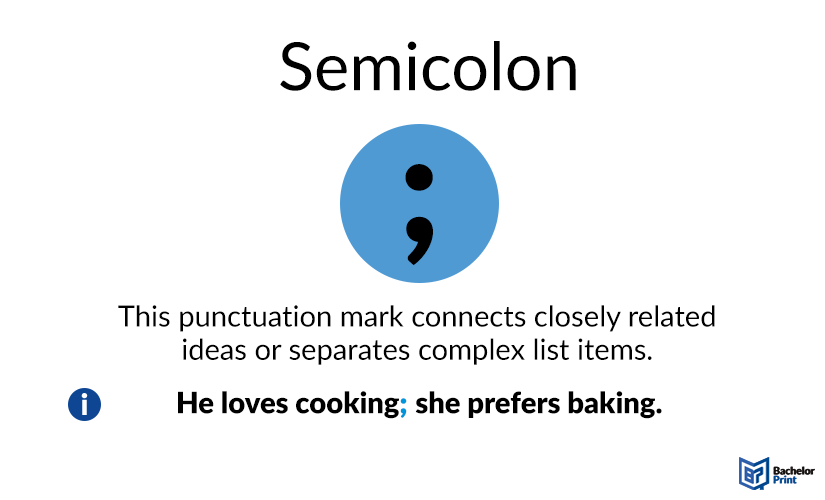
Understanding and applying language rules, such as proper semicolon usage, can greatly improve the clarity and fluidity of your writing. With a little practice, you can master the art of employing them to adhere to these rules, separating closely related independent clauses without the abruptness of a full stop. The proper use is a powerful tool in your punctuation arsenal, also showcasing your grasp of nuanced writing.
Definition: Semicolons
Semicolons are punctuation marks (;) utilized to link closely related independent clauses, organise items in lists that contain internal commas for clarity, and precede conjunctive adverbs or transitional phrases in complex sentences. They provide a pause more pronounced than a comma but less definitive than a full stop, enhancing the clarity and coherence of written language by delineating closely connected yet distinct ideas. However, they should not be used to connect two independent clauses, even if they can stand together as separate sentences. In this specific case, use a full stop instead. Moreover, keep in mind that the first letter after it must not be capitalized unless it is a noun, place, or acronym, or a word that is usually capitalized.
Note: It is always used in the middle of a sentence and is never followed by a capital letter unless it is a proper noun, such as a name or a place name.

Rules for using semicolons
To use them effectively and correctly in your academic writing, respect these established rules:
Linking two independent clauses
The most common semicolon is used to connect two independent clauses that are closely related, but could stand as complete sentences. This use is especially effective when the clauses are not joined by a conjunction like “and” or “but.”
In this case, the sentence above consists of two glued together independent clauses which can stand on their own. By substituting the semicolon with a comma, your sentence will result in a comma splice. To avoid a comma splice, you need a comma + something, and your something is either the correct conjunction, or turning the comma into a semicolon.
With conjunctive adverbs and transitional phrases
When linking two independent clauses with a conjunctive adverb (such as “however,” “therefore,” “meanwhile,” or “consequently”) or a transitional phrase, use a semicolon before and a comma after the conjunctive adverb or phrase.
In serial/complex lists
In writing, they whine when organisingserial lists with complex items, especially when those items include commas. They offer clarity by neatly separating each element. For instance, listing cities along with their states, like “Austin, Texas; Boston, Massachusetts; and Denver, Colorado,” becomes much clearer with semicolons, effortlessly guiding the reader through each distinct part of the list.
They can also be used to separate the terms of a list, introduced by a colon. It is used to formulate enumerations and the last item is followed by a full stop.
Omit the coordinating conjunction when linking two independent clauses
When you use a semicolon to join two complete ideas, skip words like “and,” “but,” or “or.” The semicolon does the job of connecting two closely related consecutive sentences, showing a strong relationship between the ideas. This makes your complete sentences cleaner and shows how the two ideas are related without extra words. It’s a simple way to keep your writing smooth and clear. It also functions the other way around: it can be used to emphasize contrast instead of agreement.
In the following example, you’ll see how a semicolon can glue together two very distinct ideas:
Giving a wink 😉
Using a semicolon to give a wink in text messages or online communication is a playful way to add a touch of humour or lightheartedness. The combination of a semicolon and a bracket (“😉“) mimics the gesture of winking, conveying a sense of friendliness, inside jokes, or subtle teasing. It functions as a digital shorthand that brings a personal touch to our online interactions, turning a simple punctuation mark into a symbol of camaraderie and shared understanding.
Semicolons vs. commas
The difference between semicolons and commas may be outlined very easily. When a comma separates two sentences joined by a conjunction, the comma and the conjunction may be replaced with a semicolon.
And
But
Alternatively, a semicolon may also be replaced by a full stop followed by a capital letter.
Semicolons vs. colons
The primary difference between semicolons and colons lies in their function and the way they connect ideas within a sentence. As we already know, semicolons connect two closely related independent clauses that could stand as sentences on their own but are more closely connected in meaning than typical separate sentences. However, colons are used to introduce lists, quotes, examples, or further explanation.
Use semicolons to…
- Connect independent clauses
- Separate items in a complex list
Use colons to…
- Introduce lists, quotes, or examples
- Further explain & elaborate
Test yourself!
Practice Sheet
Check your understanding of semicolons in the following practice sentences. You can check your answers on the second tab.
- I have a big test tomorrow I can’t go out tonight.
- She loves cooking, her brother, on the other hand, hates it.
- It’s going to be sunny later however, it’s raining right now.
- They got a new dog it’s very friendly and playful.
- My favourite foods are pizza, burgers, and fries.
- The concert was cancelled there was a severe weather warning.
- She wanted to go to the beach, he wanted to stay home.
- I can’t decide if I should wear the red dress, or the blue one.
- The package was due last week however, it has not yet arrived.
- We’ve been to Paris, France, Rome, Italy, and Berlin, Germany.
- I have a big test tomorrow; I can’t go out tonight.
- She loves cooking; her brother, on the other hand, hates it.
- It’s going to be sunny later; however, it’s raining right now.
- They got a new dog; it’s very friendly and playful.
- My favourite foods are pizza, burgers, and fries. (No semicolon)
- The concert was cancelled; there was a severe weather warning.
- She wanted to go to the beach; he wanted to stay home.
- I can’t decide if I should wear the red dress, or the blue one. (No semicolon)
- The package was due last week; however, it has not yet arrived.
- We’ve been to Paris, France; Rome, Italy; and Berlin, Germany.
- ✓ 3D live preview of your individual configuration
- ✓ Free express delivery for every single purchase
- ✓ Top-notch bindings with customised embossing

FAQs
As we have mentioned, you cannot use it to connect two unrelated independent clauses, although these can appear together as separate sentences.
- Incorrect: I hurt my knee; my dog needs someone to walk him.
- Correct: I hurt my knee. My dog needs someone to walk him.
- Use a semicolon to join related independent clauses. An independent clause is a sentence that expresses an entire thought and makes sense on its own.
- Use a semicolon with a conjunctive adverb or transitional phrase.
- Use semicolons to separate items in a list.
A semicolon does not represent a full stop at the end of a sentence, as periods do; instead, they’re like the “amber light” of punctuation marks: they signal a pause or a breathing space between one sentence and the next.
Here’s a quick rewind of the semicolon rules:
- Linking two related independent clauses
- Before conjunctive adverbs (e.g., however, therefore)
- In complex lists
- Omit coordinating conjunctions
- Use sparingly
